Regional project reports summarising profitability and riskiness of alternative management strategies for grazing businesses
Economic analyses were conducted for 5 regions across Queensland (Central, Central West, Northern Downs, Northern Gulf and Mulga Lands). A range of management strategies and technologies were assessed for each region and ranked for profitability and riskiness. Beef production systems were assessed in all regions and sheep and/or goat enterprises were also assessed in the Central West and Mulga Lands regions.
Six reports summarise the results and recommendations of economic analyses conducted to assess strategies and technologies relevant to 5 key grazing regions of Queensland.
In the Summary section at the front of each report there is a table that lists of all strategies assessed for that region with their economic outcome (profitability and riskiness).
For more information about these reports and to download copies of the reports, click on each of the buttons below.
 | 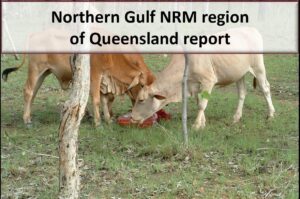 | 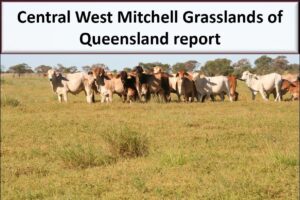 |
 |  | 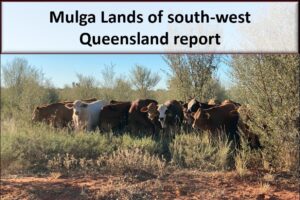 |
The Understanding farm management economics presentation explains the methods and terminology used in the farm management economic analyses conducted as part of this project.
Additionally, a series of recorded presentations explain and summarise the results and key messages from the project overall.
Fitzroy NRM region of central Queensland
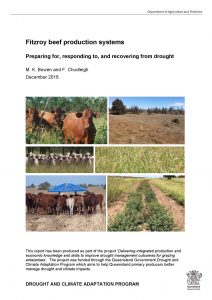 In the Fitzroy NRM region of central Queensland the assessment of alternative beef production strategies included:
In the Fitzroy NRM region of central Queensland the assessment of alternative beef production strategies included:
- leucaena, other legumes, forage oats, feedlotting and HGPs for steers
- better genetics for fertility, reducing foetal/calf loss, pestivirus management, inorganic supplements to address phosphorus deficiency, and feeding first calf heifers for breeders, and
- alternative markets such as organic beef, EU and Wagyu.
Lower cost strategies to improve drought resilience (managing breeder body condition, optimising herd structure), as well as drought response (destocking) and drought recovery (restocking) strategies, were also assessed.
Download the report: Fitzroy beef production systems – Preparing for, responding to, and recovering from drought (PDF, 3 MB)
Northern Gulf NRM region
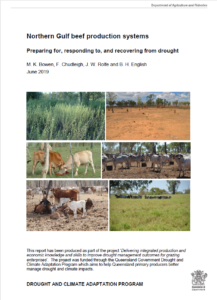 In the Northern Gulf NRM region assessment of alternative beef production strategies included:
In the Northern Gulf NRM region assessment of alternative beef production strategies included:
- addressing a decline in land condition through a reduction in stocking rates and systematic wet season spelling
- adequate wet season phosphorus supplements for all cattle
- stylos, leucaena, production feeding, silage, agistment and changing age of steer turnoff, and
- better genetics for fertility, home-bred bulls, reducing foetal/calf loss, and feeding first calf heifers for breeders.
Lower cost strategies to improve drought resilience (managing breeder body condition, optimising herd structure), as well as drought response (destocking) and drought recovery (restocking) strategies, were also assessed.
Download the report: Northern Gulf beef production systems – preparing for, responding to and recovering from drought (PDF, 4.5 MB)
Central West Mitchell Grasslands
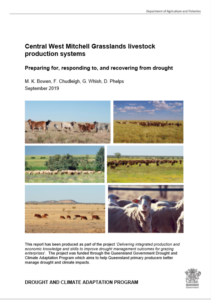 For the Central West Mitchell Grasslands, an integrated pasture and beef herd modelling approach was developed to allow the impact of climate variability on a range of grazing management scenarios (including wool) to be modelled.
For the Central West Mitchell Grasslands, an integrated pasture and beef herd modelling approach was developed to allow the impact of climate variability on a range of grazing management scenarios (including wool) to be modelled.
This bio-economic evaluation found that setting livestock numbers based on safe pasture utilisation rate principles, but adopting a moderate degree of flexibility in altering livestock numbers in response to pasture availability, is likely to be the most profitable approach to grazing management while maintaining pasture and land condition over time. However, it was essential to economic viability that re-stocking occurred as soon as possible once good seasonal conditions returned.
Tactical strategies that may be applied in response to drought were also assessed in this report, including sale of various classes of livestock, early weaning, drought feeding, and agistment.
Download the report: Central West Mitchell Grasslands — Management strategies for drought resilience (PDF, 6 MB)
Northern Downs region of Queensland
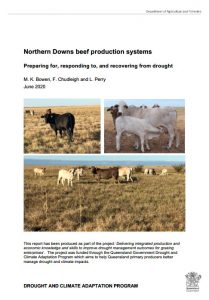 In the Northern Downs region of Queensland, assessment of alternative beef production strategies included:
In the Northern Downs region of Queensland, assessment of alternative beef production strategies included:
- increasing age of steer turnoff, and optimising cow and heifer culling age
- HGPs and molasses production mix for steers
- home-bred bulls, better genetics for fertility, reducing foetal/calf loss, first mating heifers as yearlings, and supplementing first-calf yearling heifers
- converting from breeding to steer turnover, transferring steers from a Northern Gulf property to the Northern Downs property when both were owned within the same business, purchasing a Northern Gulf breeding property, and purchasing a steer growing and finishing property in the Dawson-Callide, and
- managing prickly acacia.
Download the report: Northern Downs beef production systems – preparing for, responding to and recovering from drought (PDF, 2.7 MB)
Rangelands of central-western Queensland
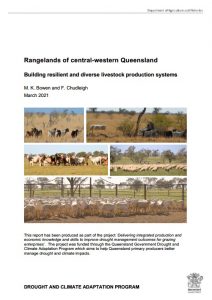 In the rangelands of central-western Queensland, the following alternative livestock enterprises were assessed for profitability and resilience:
In the rangelands of central-western Queensland, the following alternative livestock enterprises were assessed for profitability and resilience:
- self-replacing beef cattle herd
- steer finishing
- self-replacing Merino wool flock
- Merino wether sheep
- meat sheep, and
- rangeland meat goats.
- The value of integrating or fully adopting several of the alternative enterprises, from the starting point of either a self-replacing (1) beef cattle herd or (2) wool sheep flock, was also investigated.
Download the report: Rangelands of central-western Queensland – building resilient and diverse livestock production systems (PDF, 3.8 MB)
Mulga Lands of south west Queensland
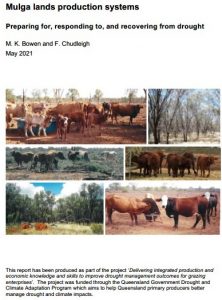 In the mulga lands of south west Queensland, assessment of alternative beef production strategies included:
In the mulga lands of south west Queensland, assessment of alternative beef production strategies included:
- implementing the safe carrying capacity through a reduction in stocking rate
- weaning, pregnancy-testing and basic vaccinations
- increasing the age of steer turnoff from yearling steers to 18 months
- inorganic supplements in the dry period (sulphur, phosphorus, nitrogen) and/or growing period (sulphur, phosphorus)
- converting from breeding to steer turnover
- controlled mating
- feeding whole cottonseed to the breeder herd
- buffel paddock development, and
- destocking in response to dry periods through a) livestock sales or b) sending breeders on agistment.
In addition, the alternative investment options of rangeland goat production and carbon farming were assessed.
Download the report: Mulga lands production systems preparing for, responding to and recovering from drought (PDF, 3 MB)
The project was funded by the Queensland Government’s Drought and Climate Adaptation Program (2017-2021).
For more information about the project please contact the project leader—Dr Maree Bowen, DPI Rockhampton at maree.bowen@dpi.qld.gov.au.
Additional information
| ← Project overview | |
| ← Key messages | |